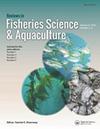Population Dynamics of Cultured Holothuria scabra in a Sea Ranch: Implications for Stock Restoration
引用次数: 30
Abstract
The potential of sea ranching sandfish (Holothuria scabra) for production and stock restoration was investigated in the Philippines. A total of 14,300 fluorochrome-stained juvenile sandfish (>3 g) were released in 8 batches over a 15-month period in a 5-hectare pilot communal sea ranch. Abundance of sandfish increased from 416 to 5,562 individuals, with a corresponding increase in biomass from 7 to 221 kg ha−1 over the 19-month period. Apparent survival over the study period was estimated at 20–30%. Incidences of in situ spawning were observed in the sea ranch within a year, and estimated densities of reproductively mature sandfish increased from 37 ind ha−1 7 months after initial release to 249 ind ha−1 after 19 months. Average weight at onset of sexual maturity (∼185 g) is estimated to be attained 7–9 months after release. Juveniles without fluorochorome stained ossicles were found during most monitoring periods, indicating presence of wild recruits. A well-managed communal sea ranch has the potential to contribute to fisheries production and stock restoration objectives.海洋牧场养殖黄斑全息鱼种群动态:对种群恢复的启示
在菲律宾调查了海牧沙鱼(Holothuria scabra)在生产和种群恢复方面的潜力。在15个月的时间里,在一个5公顷的试验性公共海洋牧场,分8批共放生14,300只荧光染色的沙鱼幼鱼(bb30 g)。在19个月的时间里,沙鱼的丰度从416增加到5562,生物量从7增加到221 kg ha - 1。研究期间的表观存活率估计为20-30%。在一年内,在海洋牧场观察到原地产卵的发生率,估计繁殖成熟的沙鱼密度从最初释放后的37个月增加到19个月后的249个月。性成熟开始时的平均体重(约185克)估计在释放后7-9个月达到。在大多数监测期间,发现没有荧光染色的幼鱼听骨,表明存在野生新兵。管理良好的公共海洋牧场有可能有助于实现渔业生产和种群恢复目标。
本文章由计算机程序翻译,如有差异,请以英文原文为准。
求助全文
约1分钟内获得全文
求助全文

 求助内容:
求助内容: 应助结果提醒方式:
应助结果提醒方式:


